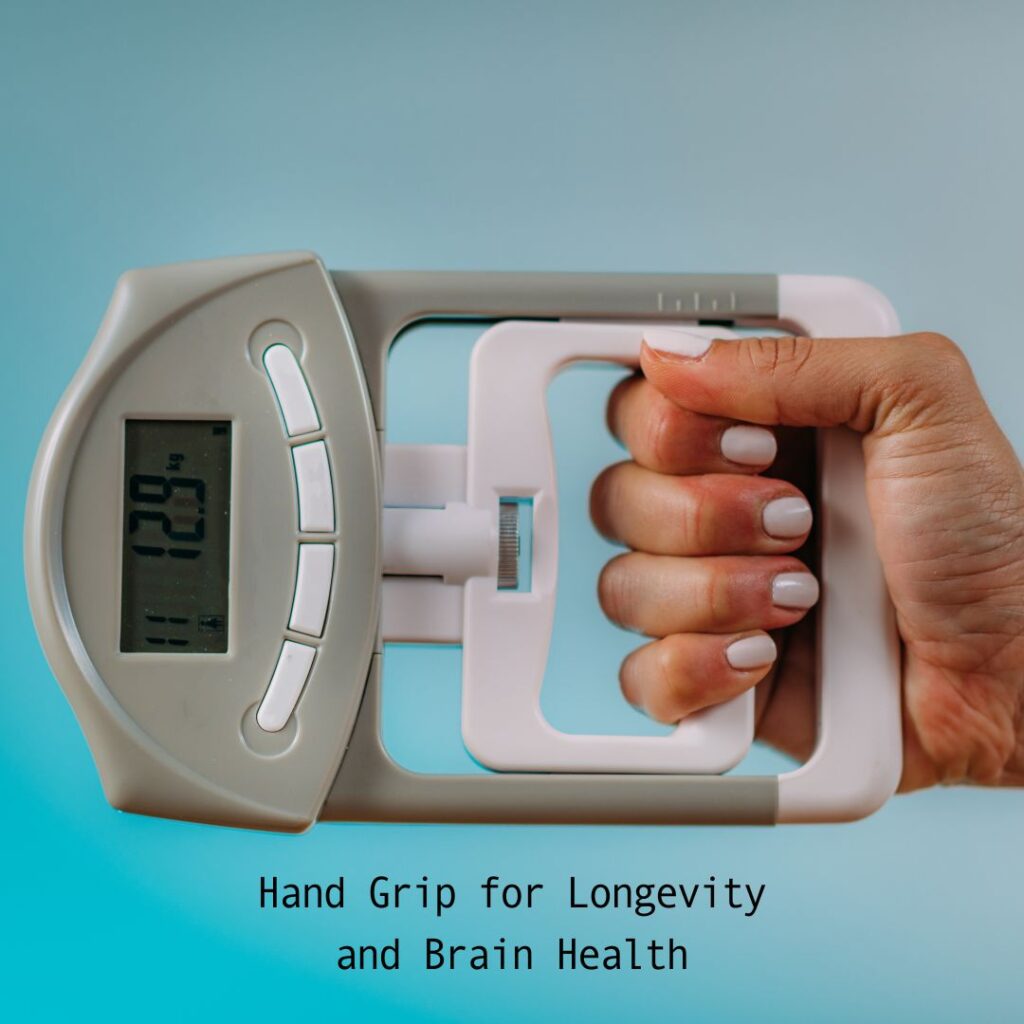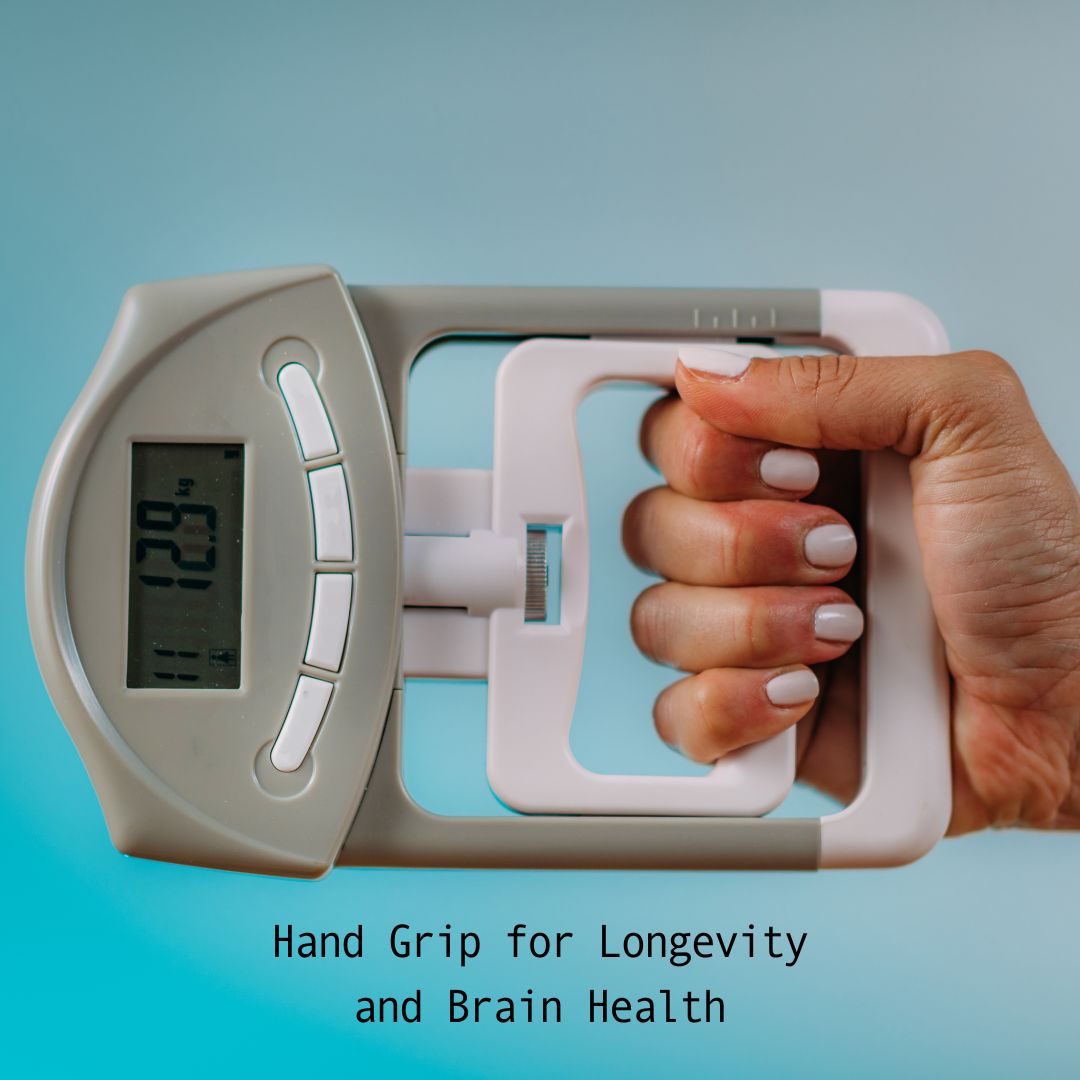
When was the last time you gave much thought to the strength of your grip? While it might seem like just another measure of physical fitness, research suggests that your grip strength is far more than that—it’s a window into your overall health, longevity, and brain health.
We will explore the connection between grip strength and long-term health outcomes, including cognitive function and chronic diseases, while offering practical steps to measure and improve it. Prepare to see this biomarker in a new light—it may even sharpen your focus on leading a healthier, longer life. I learned about the importance of this biomarker in my High-Performance Coaching class with Dr. Stephen Cabral, which was enlightening. Dr. Cabral suggests tracking your hand-grip strength quarterly with a hand dynamometer.
Is Grip Strength a Predictor of Long-Term Brain Health?
Yes, grip strength is more than an indication of physical ability. Research increasingly suggests it’s a key biomarker for brain health. A Harvard article that referenced a 2022 study published in the Journal of the American Medical Directors Association found a strong link between this biomarker and cognitive performance across various age groups. Those with higher grip strength tended to score better on memory, attention, and problem-solving skills tests.
But why does this correlation exist? Grip strength reflects the health of your neuromuscular system, which connects the brain and muscles. A decline in this marker may hint at diminished brain function as an early warning sign of cognitive decline.
How Does Grip Strength Relate to Overall Brain Health and Longevity?
Grip strength has been called the “new vital sign” because of its strong ties to overall health. Studies have shown that it can predict brain health and overall longevity. For example, a 2018 The Lancet study found that low grip strength was associated with an increased risk of cardiovascular mortality, respiratory diseases, and cancer.
The theory is simple—better grip strength suggests robust muscle health, often a marker of better overall condition. People with greater muscular fitness tend to be more active, sleep better, and recover quickly from illness.
Can Grip Strength Predict Chronic Disease Risk?
Absolutely. Weak grip strength may predict the onset of multiple chronic conditions such as diabetes, hypertension, and heart disease. Dr. Peter Attia, a physician focused on longevity and author of Outlive: The Science and Art of Longevity, highlights this marker as a simple yet powerful indicator of functional aging. He explains in this article that lower grip strength is often a sign of sarcopenia, or muscle loss, linked to metabolic disorders.
One study (Associations of grip strength with cardiovascular, respiratory, and cancer outcomes and all cause mortality: prospective cohort study of half a million UK Biobank participants) published in The BMJ in 2018 noted that individuals with stronger grip strength had significantly lower risks of cardiovascular diseases and type 2 diabetes. If you’re looking for an easy way to assess your risk levels, this is one of the metrics.
Can Grip Strength Predict Brain Health?
Grip strength’s predictive power extends into the field of neurology. A notable 2019 study in JAMA Network Open revealed that lower grip strength was linked to faster rates of cognitive decline in older adults. The study tracked nearly 14,000 participants over eight years and found that decreases in this marker closely mirrored declines in memory and executive function.
How Is Grip Strength Measured?
Measuring this marker is simple and non-invasive. A hand dynamometer assesses how much force you can exert when squeezing an object. Here’s how the test works:
- You hold the dynamometer in your dominant hand.
- Squeeze as hard as you can for 3 seconds.
- The highest reading over several attempts is recorded as your grip strength.
Fitness centers, physiotherapy clinics, and even some doctor’s offices often have dynamometers available. Finding where you stand is easy if you’re curious about your grip strength.
Optimal Measurements
Optimal grip strength varies by age and gender. For example, according to optimal data (listed on the hand dynamometer’s product page in the middle):
- Men aged 55-59 should aim for more than 106.7 pounds of force. The standard reference range would be between 67.5 lbs and 106.7 lbs.
- Women aged 55-59 should aim for a force above 69.3 pounds. The standard reference range would be 38.9 lbs—69.3 lbs.
This marker naturally declines with age, but maintaining ranges within the norm for your demographic is crucial for overall health and functionality.
At What Age Does Grip Strength Start to Decline?
This marker typically peaks in your late 20s to early 30s. From then on, it gradually declines, losing approximately 1% to 2% per year after age 50. However, the rate of decrease can accelerate if physical activity is neglected. The good news? It’s never too late to strengthen your grip and ward off these effects.
Can Improving Grip Strength Benefit Brain Health?
The connection between grip strength and neural function means that strengthening your grip isn’t just about opening pickle jars—it could potentially safeguard your brain. Research suggests that physical activity, particularly strength training, has neuroprotective benefits. By improving this biomarker, you may also be boosting cognitive resilience.
How Can I Improve My Grip Strength Effectively?
Building grip strength doesn’t require complicated equipment or hours in the gym. Here are three key strategies:
- Consistency is Key: Incorporate grip-strengthening exercises 2–3 times per week.
- Target All Angles: Include exercises focusing on crush grip, pinch grip, and static holds.
- Use Simple Tools: Resistance bands, hand grippers, and even household items like towels can be used for exercises.
Best Exercises for Increasing Grip Strength
Here’s a list of practical exercises to get you started:
Crushing Grip
- Hand Gripper Squeezes – Use a hand gripper to strengthen your finger and palm.
- Farmer’s Carries – Grab a heavy dumbbell, bags full of groceries, or a kettlebell in each hand and walk 20–30 feet.
Pinch Grip
- Plate Pinches – Pinch two weight plates together and hold them for as long as possible.
Static Grip
- Dead Hangs – Hang from a pull-up bar for 20–30 seconds.
Whatever your chosen exercise, remember to focus on form and avoid overtraining—your hands and forearms need time to recover, too. Also, check with your physician before starting any exercise program.
Stronger Hands, Sharper Mindset
Grip strength is more than a measure of physical fitness—it’s a vital indicator of overall health, longevity, and brain power. By understanding its significance and taking actionable steps to improve it, you invest in physical strength and a longer, sharper, healthier life.
Whether you’re 25 or 75, this biomarker matters. Take the first step today by measuring this biomarker and incorporating strength-building exercises into your routine. Over time, you’ll see the difference reflected in your overall vitality.
Join the Movement
Stay informed, get inspired, and connect with a like-minded community of women passionate about brain and hormone health. Subscribe to our newsletter below and explore how you can elevate your mind and life. If you are interested in health coaching with me, please visit my coaching page to learn more. Together, we’ve got this!
Medical and Affiliate Disclaimer
I am not a licensed medical professional, and the information I’ve shared in this blog post is for general informational purposes only. The content of this blog post is not intended to substitute for professional medical advice, diagnosis, or treatment. Always seek the advice of your physician or other qualified health provider with any questions you may have regarding a medical condition.
This blog post may contain affiliate links. If you click on these links and make a purchase, I may receive a commission at no additional cost. As an Amazon Associate, I earn from qualifying purchases.





